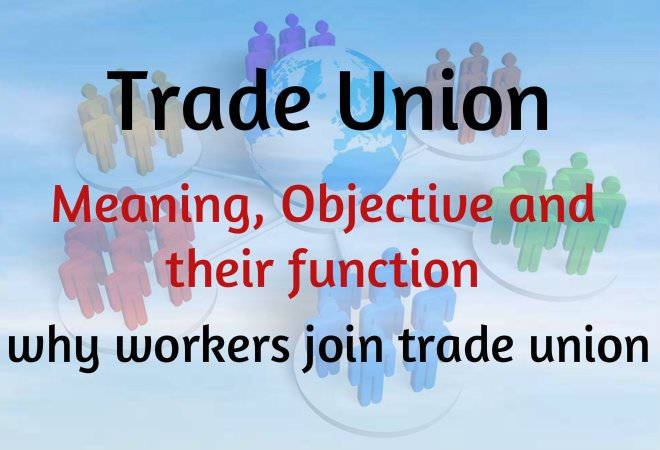Trade unions are voluntary organisations of employees or employers formed to promote and protect their interests through collective action. Though the terms employees and employers are used, when we say trade unions they generally refer to employees.
Definition of Trade union
According to GD.H. Cole , a trade unions “an association of workers in one or more professions an association carried on mainly for the purpose of protecting and advancing the members economic interests in connection with their daily work.
Dale Yoder defined a trade union as “a continuing long-term association of employees, formed and maintained for the specific purpose of advancing and protecting the interest of the members in their working relationship.
Accroding to S.D. Punekar, “a union is a continuous association of persons in the industry whether employer or independent workers formed primarily for the purpose of the pursuit of the interests of its members of the trade they represent.
Indian Trade union Act defined in 1926 of trade unions as “any combination, whether temporary or permanent, formed primarily for the purpose of regulating the relations between workmen and employers or between workmen and workmen, between employees and employer or for federation of two or more trade unions.
Characteristics of trade union
An analysis of the above definitions on trade unions reveals the following pointed characteristics of trade unions:
Point 1: The trade unions may be association either of the employers or employees or of independent workers.
Point 2: Trade unions are relatively permanent combination of workers and are not temporary or casual.
Point 3: Trade union is an association of workers who are engaged in securing economic benefits for their members.
Point 4: The character of trade unions has been constantly changing.
Point 5: The origin and growth of trade unions has been influenced by an number of ideologies.
Functions of Trade union
The basic functions of unions are to protect and promote the interest of the workers and conditions of their management. The other factor are:
Factor 1: Achieving higher wages and better working and living conditions for the members.
Factor 2: Acquiring the control of industry by workers.
Factor 3: Minimizing the helplessness of the individual workers by making them stand collectively and increasing their resistance power through bargaining.
Factor 4: Protecting the members against victimization and injustice of the employers.
Factor 5: Raising the status of the workers as partners of the industry and citizens of society by demanding increasing share for the workers in the management of industrial enterprises.
Factor 6: Providing a worker self-confidence and a feeling that he is not simply and clog in the machine.
Factor 7: Imbibing sincerity and discipline in workers.
Factor 8: Taking up welfare measures for improving the morale of the workers.
Factor 9: To protect the right of to be consulted on all the matters affecting the worker’s interest.
The national commission of labour has pointed out the following basic functions on which the trade unions have to pay greater attention:
Factor 1: To secure for workers fair wages.
Factor 2: To safeguard security of tenure and improve conditions of service.
Factor 3: To enlarge opportunities for promotion and training.
Factor 4: To improve working and living conditions.
Factor 5: to provide for educational, cultural and recreational facilities.
Factor 6: To cooperate in and facilitate technological advance by broadening the understanding of workers on its underlying issues.
Factor 7: To promote identity of interests of the workers with their industry.
Factor 8: To offer responsive co-operation in improving levels of production and productivity, discipline and high standard of quality and generally.
Factor 9: To promote individual and collective welfare.
Why do workers Join trade union?
Workers join trade unions to achieve their objectives which they could not achieve individually.
Specifically, workers join trade unions due to the following reasons?
Reason 1: To attain economic security. In other works, securing permanent employment with higher salary and benefits.
Reason 2: To improve their bargaining power and balance it with it with that of the management. Workers can resist the management by improving their bargaining power which in turn requires joining in trade unions.
Reason 3: To ventilate the workers grievances to the management.
Reason 4: To inform workers views, aims, ideas and dissatisfaction to the management.
Reason 5: To secure protection from unexpected economic needs like illness, accidents, injury etc.
Reason 6: To satisfy their social needs.
Reason 7: To satisfy their psychological needs.
Reason 8: To satisfy their needs for belonging
Reason 9: To secure power.
Trade Union Structure
The structure of trade unions in India varies form organisation to organisation. However, the structure can be classified into four types.
- Craft Unions
- General Unions
- Industrial Unions
- Federation and Confederation
Type 1: Craft Unions
If the workers of the same craft or category of the job form into an union, that union is called craft union. These Unions are called as horizontal Unions.
The basic logic behind the formation of such unions is that the workers belonging to the same craft do face similar problems mostly non-managerial personnel form such union in Indian Railways.
Type 2: General Unions
If the workers of any industry, any region and of any or occupation form into one union in order to protect the overall interests of the workers, such unions are called general unions.
Type 3: Industrial Unions
If the workers of different categories form into a Union, that Union is called Industrial Union. These Unions are also called Vertical Unions.
The logic behind the formation of these unions is that workers of the same industry have the common bend and they are governed by same rules and regulations and are administered by the same management.
Type 4: Federation and Confederation
Industrial Unions, either of the same industry or of the different industry may form into an association in order to improve. Trade Union unity/strength. Such a union are called Federations.
During the critical situations, Unions/Federations in different industries may resort to concerted action without losing their individuality.
In such situations, the federations form into an association and such an association is called Confederation.
Measures to strengthen Trade Union Movement In India
The leadership of most of the Trade Union in India has been outside leadership mainly drawn from political parties. As the labour movement in India is deeply involved in the policies and politicians. Moreover, the problem of trade unions are like a vicious circle.
The following are some of the measure to minimize trade union problems and to strengthen the trade union movement in India.
Measure 1: Development of United Labour front. Developing a united front with one policy, objective, programme and method can eradicate most of the present day’s trade union problems.
Measure 2: Development of efficient leadership. Outside political leadership has been developed due to the absence of internal leadership. Outside leadership is the main cause for the multiple problems of the trade union.
Management and trade unions should provide educational and training facilities for the development of internal leadership.
Measure 3: The membership fee should be raised as the amount of wages of the workers increased significantly, compared to the situation in 1926 when the Trade union act provided for the collection of 25 paise per member per month as subscription fee.
Measure 4: Trade unions should extend welfare measures to the members and actively render social responsibilities.
Measure 5: The trade union Act, 1956, should be amended and the number of members required to form a trade union should be increased from 7% to 50% of the employees of an organisation.
Similarly, the scope for the outside leadership should be reduced from 50% to 10%. The membership subscription should be enhanced from 25 paise to 1% of the monthly wages of the worker.
Measure 6: The trade union Act should be amended in order to avoid dual membership.
Measure 7: There should be legal provision for the recognition of the representative union.
Measure 8: Trade Unions Should not unnecessarily interface in the management decision, where their interference reduces the organisational effectiveness.
Measure 9: Trade Unions should form a labour party and trade unions in the country should be affiliated to it. It gives adequate strength to the trade unions both in the industry and in the parliament.
A last words, Trade Unions employ tactics to deal with management. Trade unions is benefit for employees because they are support to him. But several times trade unions is the problems for an organisation because unionising, strike, invoking, patronage and blackmailing are the most common tactics used by unions.














Pretty! This was an extremely wonderful article. Thank you for providing these details.